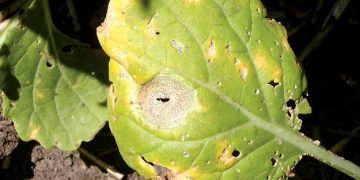#PlantDisease #FungalPathogens #CropLoss #DiseaseResistance #Agriculture #CropManagement
Leptosphaeria maculans, also known as blackleg fungus, is a major fungal pathogen that affects many cruciferous crops such as canola, cabbage, and broccoli. The fungus causes a disease known as blackleg, which can result in significant yield losses, quality reduction, and economic losses for farmers.
Development of Black Ring Spot
The disease spreads through spores, which can be present in the soil or carried by wind, water, or equipment. The fungus infects the plant through wounds or natural openings and produces toxins that kill the plant tissue. The symptoms include the appearance of black lesions on the stem, which can girdle and kill the plant. The disease can also cause premature ripening and shattering of the seed pods, resulting in reduced yield and seed quality.
Consequences of Development
The impact of black ring spot on cruciferous crops can be severe. In severe cases, it can cause complete crop failure, which can have significant economic consequences for farmers. The fungus can also reduce the quality of the harvested crop, making it less attractive to buyers. Additionally, the disease can persist in the soil for several years, making crop rotation challenging and increasing the risk of future outbreaks.
Prevention and Management
The best way to prevent blackleg disease is to use disease-resistant cultivars, rotate crops, and maintain good field hygiene by removing crop debris and minimizing soil disturbance. Fungicides can also be used to manage the disease, but their effectiveness can vary depending on the timing and severity of the outbreak.
In conclusion, Leptosphaeria maculans is a significant threat to cruciferous crops, causing black ring spot disease that can result in severe economic losses for farmers. Preventive measures such as using disease-resistant cultivars, crop rotation, and good field hygiene can help manage the disease and minimize its impact.
































